There is no doubt that the COVID-19 pandemic’s effect on the workplace are yet to be extinguished; Far from it. The long-term impacts are only just emanating from the more controlled spread of the virus.
One particular ‘after shock’ of the cataclysmic event, is the way employees look at their workplace. This is no longer JUST where I go to get paid, it has become a much more essential part of our lives.
When we were shifted to work from our homes, café’s, shared workspaces, it forced us to re-wire our behavioural neural pathways, which has led to confusion, detachment and at times distress. In a previous article we wrote in March this year, we spoke about the effect of burnout on employees. Today we emphasise that this is not exclusive to frontline or middle management employees, but is a factor that has increased also in leadership and C-Suite roles.
A recent Harvard Business Review article carried a summary of a 2021 Mind Share partners’ Mental Health at Work Report (MSP) which highlighted that more than three quarters of respondents in the USA have reported at least an episode of mental health concern. This result is up by 29% from the same study in 2019.
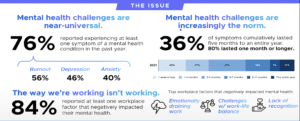
Main symptoms reported.
Mental health is a wide-ranging area of study which has no singular contributor. Below we will outline some of the key factors leading to the results reported in the 2021 study. Even though the report highlights the situation in the USA, the report reflects the same trends of an EU Compass Report on mental health in the workplace from 2017.
Burnout, Depression and Anxiety were the most common, with reportees declaring that the symptoms lasted from one month to an entire year for over 36% of respondents. The prevalence was reported at Executive and C-Suite levels with 82% and 78% reporting at least one incident during the course of the year respectively. The figure drops to 71 for managers and individual contributors.
Causes:
“84% of respondents reported at least one workplace factor that negatively impacted their mental health in the past year—the most common being:
– emotionally draining work (37%)
– challenges with work-life balance (32%)
– Low sense of connection or support from colleagues/manager (29%)
– poor communication practices (26%)
– discrimination or harassment (26%), and
– lack of recognition for work done (25%).“ (MSP, 2021)
The “always-on” syndrome that has afflicted many due to the erosion of barriers between professional work and home obligations was a common feature in the report. These factors have led to higher rates of attrition: 78% of Millennials, 81% of Gen-Z employees, 38% among Gen X population and 12% of Baby Boomers which more than doubled since 2019.
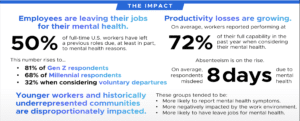
The result is not just detrimental to the individual, but it has had significant effect on business productivity, with over 77% of respondents confirming the negative impact of mental health on their productivity. Globally, in 2018, Lancet Commission researchers estimated the impact of mental health will cost the economy $16 TRILLION by 2030! This means over 12 billion working days lost to mental illness annually and $216 billion dollars a year in losses. This was a year before the COVID-19 pandemic tipped the world on its head!
Symptoms of the impact of mental health on individual productivity include:
38% – Difficulty concentrating (31% increase from 2019, 29%).
32% – Avoiding social activities (33% increase from 2019, 24%).
24% – Difficulty thinking, reasoning, or deciding (6% increase from 2019, 19%).
23% – Being less responsive to email and other communications (64% increase than in 2019, 14%).
21% – Taking longer to do tasks (31% increase from 2019, 16%). (MSP, 2021)
What can you do?
Five key suggestions from the MSP 2021 report on what you can to enhance your workplace environment and minimise mental health issues escalating, while making your business more mental health friendly include;
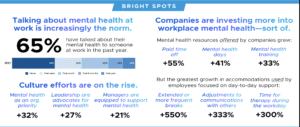
- Mental health is a collective priority: Every organisation is about the collective. If our attitude and behaviour towards mental health, is one dealt with in isolation, then we instil a culture of indifference and stigma. On the other hand, if the collective approach to mental health wellbeing is one that is part of everyone’s responsibility, you build a culture of care, attention and psychological safety, which is at the core of a trusting, open and collaborative organisation.
- It starts with the leaders: Leaders set the tone, pace and direction of an organisation. If leadership is aloof from what is going on, then aloofness will reign. Acceptance and vulnerability are the first steps in addressing mental health issues. If leaders perceive this as a weakness, then so will employees, as they fear to default on their job role obligations. Adopt the Model. Participate. Create. Act.approach to instil trust and connection.
- Coach, train, mentor: Leaders, managers are not equipped to deal with mental health issues, so provide your leadership with the resources to support people better. While it should never replace the availability of professional support, managers and leaders are some of the first people employees go to in times of distress (if there is enough trust). Inculcate a nurturing, coaching culture led by a ‘human-centric leadership’ style to equip your leaders with the people skills to ensure their wellbeing and not their task list completion.
- Practice what you preach – prioritise healthy and sustainable ways of working: It is great to talk about mental health and raise awareness about its perils, but it’s worth very little if your work culture, environment, practices remain the same and continue to reinforce a toxic work environment.
- Ensure organisational and individual purpose, values, expectations, norms are aligned to facilitate work-life coordination.
- Take advantage of the extended workplace to give people more flexibility in work practices, autonomy, decision-making roles; It will increase fulfilment.
- Consistently, and continuously. Engagement is a result of the relationships you build. Make this a centrepiece of your organisation.
- Leverage integration, diversity, equality: The changing dynamics of our workplace and communities is such that brings about great opportunities for a workplace to enhance its culture with the richness of its’ population’s diversity. Set-up fora that allow liberal exchanges on policy, processes, structure to leverage a truly ‘collective intelligence’.
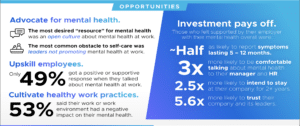
Think of culture as an ‘ecosystem framework’ (See image 1 below. MSP, 2021), where all elements come together in understanding of their mutual impact and benefit.
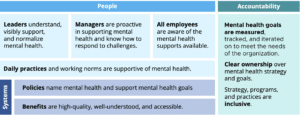
If you want to find out more on how we can help you and your business be more mental health friendly, contact us on academy@upyourlevel.com.



